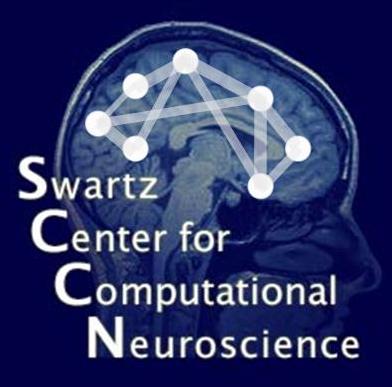
SCCN Home
EEGLAB Home
Workshop Program
The videos of the Workshop talks have been divided into Chapters to facilitate their use for online review and study.
Press FS on the lower right corner of the video image to view the talk in full screen display.
You may download the (.pdf) slides used in the talk here.
To link another web page to a chapter N below, use the URL title of this page followed by #ChapterN .
This Talk --
Scott Makeig, Director of the Swartz Center for Computational Neuroscience, UCSD,
and founder and co-developer, with Arnaud Delorme, of the EEGLAB project,
ended the first Session of the Workshop with an review and overview
of topics and tools available in and motivating the development of the EEGLAB environment.
Chapter 2 (10:25)
reviews the use of sptial source filtering by ICA decomposition for EEG analysis,
gives additional examples of its use, and reviews some of its benefits.
Chapter 3 (3:35)
continues the discussion of the value of ICA decomposition applied to EEG data, including the tendency for the scalp projections of independent component EEG processes to closely resemble the projection of a single cortical patch.
Chapter 4 (5:30)
continues reviewing the nature of ICA decompositions of high-density EEG data, focusing on similarities in independent component processes across subjects and task conditions.
Chapter 5 (15:49)
describes results of ICA decomposition of event-related dynamics following appearance of visual target stimuli in a spatial selective attention task, as reported in Makeig et al.,
Electroencephalographic brain dynamics following visual targets requiring manual responses. PLOS Biology, 2(6):742-762, 2004.
Chapter 6 (7:04)
demos and discusses results of ICA and event-related spectral perturbation (ERSP) analysis
of a passive spatial 'tunnel' navigation task recently reported by Klaus Gramann et al.,
Brain dynamics accompanying use of egocentric and allocentric reference frames during human navigation.
Journal of Cognitive Neuroscience, 2010 ( doi:10.1162/jocn.2009.21369).
Chapter 7 (2:24)
presents still unpublished results from a study of Vicky Bjerre (Copenhagen) of the spatial distribution of independent component processes appearing during a sptial working memory task in three subject groups (children, young adults, older adults).
Chapter 8 (13:05)
reviews the concept that brains 'meet the challenge of the moment' by organizing and supporting behavior that achieves optimal results for the actor (and/or a social group they identify with). This chapter presents a new strategy for better understanding this process, a strategy that records both high-density EEG and human body motion data, constituting in effect a new mode of human functional brain imaging
that we call Mobile Brain/Body Imaging or MoBI. Two unpublished results of active 3-D orienting and balancing experiments are given to hint at the potential interest and power of this approach. Finally, this chapter summarizes several new EEGLAB-related toolbox and other software projects ongoing at UCSD that are covered in more detail in the second part of the Workshop.
Return to the Workshop Program, to the Makeig home page, or to the EEGLAB home page.
Chapter 1 (5:47)
reviews the origin of EEG in patches or 'avalanches' of local cortical phase synchrony.